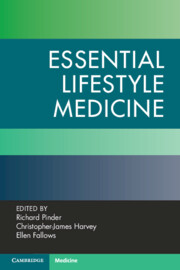Book contents
- Essential Lifestyle Medicine
- Reviews
- Essential Lifestyle Medicine
- Copyright page
- Contents
- Contributors
- Preface
- Section 1 An Introduction
- Chapter 1 What Is Lifestyle Medicine?
- Chapter 2 Paradigms in Medicine and Society
- Chapter 3 Historical and Global Perspectives in Lifestyle Medicine
- Section 2 Foundation Knowledge of Lifestyle Medicine
- Section 3 The Lifestyle Medicine Pillars
- Section 4 Clinical Skills in Lifestyle Medicine
- Section 5 Transforming Medicine
- Index
- References
Chapter 1 - What Is Lifestyle Medicine?
from Section 1 - An Introduction
Published online by Cambridge University Press: 01 May 2025
- Essential Lifestyle Medicine
- Reviews
- Essential Lifestyle Medicine
- Copyright page
- Contents
- Contributors
- Preface
- Section 1 An Introduction
- Chapter 1 What Is Lifestyle Medicine?
- Chapter 2 Paradigms in Medicine and Society
- Chapter 3 Historical and Global Perspectives in Lifestyle Medicine
- Section 2 Foundation Knowledge of Lifestyle Medicine
- Section 3 The Lifestyle Medicine Pillars
- Section 4 Clinical Skills in Lifestyle Medicine
- Section 5 Transforming Medicine
- Index
- References
Summary
Lifestyle Medicine is an evidence-based medical discipline that emphasises behaviour change to improve overall health, focusing on mental wellbeing, social connections, healthy eating, physical activity, sleep, and minimising harmful behaviours. The approach bridges clinical practice with public health interventions, targeting both individual and population health. It is effective in preventing, treating, and sometimes reversing chronic diseases through lifestyle modification. Clinicians practising Lifestyle Medicine support actions beyond clinical consultations, advocating for healthy environments and policies. The discipline also addresses the challenges of non-communicable diseases and enhances resilience against infectious diseases. It offers an alternative to over-medicalisation, promoting self-care and lifestyle changes alongside traditional medical treatments. The new medical paradigm recognises the modifiability of gene expression and the importance of lifestyle factors in health outcomes. Lifestyle Medicine is increasingly integrated into medical education and healthcare delivery systems. It aligns with the shift towards person-centred care that focuses on patients’ values and goals, contributing to a more holistic approach to health and wellbeing.
Keywords
Information
- Type
- Chapter
- Information
- Essential Lifestyle Medicine , pp. 1 - 14Publisher: Cambridge University PressPrint publication year: 2025
